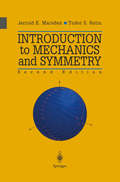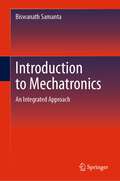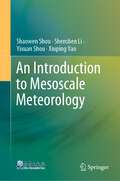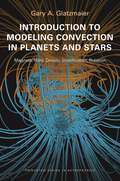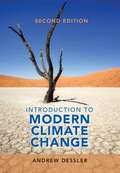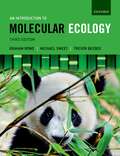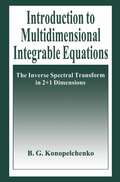- Table View
- List View
An Introduction to Mathematical Relativity (Latin American Mathematics Series)
by José NatárioThis concise textbook introduces the reader to advanced mathematical aspects of general relativity, covering topics like Penrose diagrams, causality theory, singularity theorems, the Cauchy problem for the Einstein equations, the positive mass theorem, and the laws of black hole thermodynamics. It emerged from lecture notes originally conceived for a one-semester course in Mathematical Relativity which has been taught at the Instituto Superior Técnico (University of Lisbon, Portugal) since 2010 to Masters and Doctorate students in Mathematics and Physics. Mostly self-contained, and mathematically rigorous, this book can be appealing to graduate students in Mathematics or Physics seeking specialization in general relativity, geometry or partial differential equations. Prerequisites include proficiency in differential geometry and the basic principles of relativity. Readers who are familiar with special relativity and have taken a course either in Riemannian geometry (for students of Mathematics) or in general relativity (for those in Physics) can benefit from this book.
Introduction to Matrix Theory
by Arindama SinghThis book is designed to serve as a textbook for courses offered to undergraduate and postgraduate students enrolled in Mathematics. Using elementary row operations and Gram-Schmidt orthogonalization as basic tools the text develops characterization of equivalence and similarity, and various factorizations such as rank factorization, OR-factorization, Schurtriangularization, Diagonalization of normal matrices, Jordan decomposition, singular value decomposition, and polar decomposition. Along with Gauss-Jordan elimination for linear systems, it also discusses best approximations and least-squares solutions. The book includes norms on matrices as a means to deal with iterative solutions of linear systems and exponential of a matrix. The topics in the book are dealt with in a lively manner. Each section of the book has exercises to reinforce the concepts, and problems have been added at the end of each chapter. Most of these problems are theoretical, and they do not fit into the running text linearly. The detailed coverage and pedagogical tools make this an ideal textbook for students and researchers enrolled in senior undergraduate and beginning postgraduate mathematics courses.
Introduction to Measure Theory and Functional Analysis (UNITEXT #89)
by Piermarco Cannarsa Teresa D'AprileThis book introduces readers to theories that play a crucial role in modern mathematics, such as integration and functional analysis, employing a unifying approach that views these two subjects as being deeply intertwined. This feature is particularly evident in the broad range of problems examined, the solutions of which are often supported by generous hints. If the material is split into two courses, it can be supplemented by additional topics from the third part of the book, such as functions of bounded variation, absolutely continuous functions, and signed measures.This textbook addresses the needs of graduate students in mathematics, who will find the basic material they will need in their future careers, as well as those of researchers, who will appreciate the self-contained exposition which requires no other preliminaries than basic calculus and linear algebra.
Introduction to Mechanics and Symmetry: A Basic Exposition of Classical Mechanical Systems (Texts in Applied Mathematics #17)
by Jerrold E. Marsden Tudor S. RatiuA development of the basic theory and applications of mechanics with an emphasis on the role of symmetry. The book includes numerous specific applications, making it beneficial to physicists and engineers. Specific examples and applications show how the theory works, backed by up-to-date techniques, all of which make the text accessible to a wide variety of readers, especially senior undergraduates and graduates in mathematics, physics and engineering. This second edition has been rewritten and updated for clarity throughout, with a major revamping and expansion of the exercises. Internet supplements containing additional material are also available.
Introduction to Mechatronics: An Integrated Approach
by Biswanath SamantaThis textbook presents mechatronics through an integrated approach covering instrumentation, circuits and electronics, computer-based data acquisition and analysis, analog and digital signal processing, sensors, actuators, digital logic circuits, microcontroller programming and interfacing. The use of computer programming is emphasized throughout the text, and includes Matlab for system modeling, simulation, and analysis; LabVIEW for data acquisition and signal processing; and C++ for Arduino-based microcontroller programming and interfacing. Prof. Samanta provides numerous examples along with appropriate program codes, for simulation and analysis, that are discussed in detail to illustrate the concepts covered in each section. The book also includes the illustration of theoretical concepts through the virtual simulation platform Tinkercad to provide students virtual lab experience.
Introduction to Medical Geology (Erlangen Earth Conference Series)
by C. B. Dissanayake Rohana ChandrajithOver two billion people live in tropical lands. Most of them live in intimate contact with the immediate geological environment, obtaining their food and water directly from it. The unique geochemistry of these tropical environments have a marked influence on their health, giving rise to diseases that affect millions of people. The origin of these diseases is geologic as exemplified by dental and skeletal fluorosis, iodine deficiency disorders, trace element imbalances to name a few. This book, one of the first of its kind, serves as an excellent introduction to the emerging discipline of Medical Geology.
An Introduction to Mesoscale Meteorology
by Shaowen Shou Shenshen Li Yixuan Shou Xiuping YaoThis book provides a comprehensive introduction of mesoscale meteorology which is one of the important branches of meteorology, studying majorly mesoscale atmospheric systems. It focuses on introduction of the basic knowledge about mesoscale meteorology. It contains the features and equation set of mesoscale atmospheric motions, the topographically forced mesoscale circulations, the gravity waves in free atmosphere, the front and jet stream, the mesoscale convective systems (MCSs), the atmospheric instability, the factors effecting the development of MCSs, mesoscale weather diagnosis and forecasting. This book provides many figures and basic formulas to help reader understanding the basic knowledge. What is mesoscale weather system? How the mesoscale systems influence severe disaster weather? How to forecast the mesoscale severe disaster weather? You will find the answers in it. This book will be of interest to both graduate students majoring in meteorology and the meteorological researchers.
Introduction to Methods of Approximation in Physics and Astronomy (Undergraduate Lecture Notes in Physics)
by Maurice H. van PuttenThis textbook provides students with a solid introduction to the techniques of approximation commonly used in data analysis across physics and astronomy. The choice of methods included is based on their usefulness and educational value, their applicability to a broad range of problems and their utility in highlighting key mathematical concepts. Modern astronomy reveals an evolving universe rife with transient sources, mostly discovered - few predicted - in multi-wavelength observations. Our window of observations now includes electromagnetic radiation, gravitational waves and neutrinos. For the practicing astronomer, these are highly interdisciplinary developments that pose a novel challenge to be well-versed in astroparticle physics and data-analysis.The book is organized to be largely self-contained, starting from basic concepts and techniques in the formulation of problems and methods of approximation commonly used in computation and numerical analysis. This includes root finding, integration, signal detection algorithms involving the Fourier transform and examples of numerical integration of ordinary differential equations and some illustrative aspects of modern computational implementation. Some of the topics highlighted introduce the reader to selected problems with comments on numerical methods and implementation on modern platforms including CPU-GPU computing.Developed from lectures on mathematical physics in astronomy to advanced undergraduate and beginning graduate students, this book will be a valuable guide for students and a useful reference for practicing researchers. To aid understanding, exercises are included at the end of each chapter. Furthermore, some of the exercises are tailored to introduce modern symbolic computation.
An Introduction to Mine Hydrogeology (SpringerBriefs in Water Science and Technology)
by Pradipta Kumar DebAn Introduction to Mine Hydrogeology briefly describes the subject of hydrogeology so that this knowledge can be integrated into mine development planning. It emphasizes not only the hydrochemical but also the physical impacts of the hydrogeological environment on the mine and its surroundings. Further, it discusses the methodologies used in mine hydrogeological studies, showcased by selected studies on Indian mines.
Introduction to Mineralogy: Crystallography and Petrology
by Carl W. CorrensThe first edition of this book has been out of print for seven years. The ques tion as to whether a new edition should be produced was answered affirmatively on many counts. I think that the considerations which led me to write this book in 1949 are still valid (see Preface to the First Edition). Moreover, a description of those areas of interest which together comprise the field of Mineralogy seems to be more necessary than ever, because of the rapid advances which have been made. Due to the rapid extension of our knowledge, I did not dare again to treat the whole field by myself. Accordingly, Professor ZEMANN kindly agreed to revise the first part of the book dealing with Crystallography. He made many important corrections. In Part II the basic question arose as to whether the physical-chemical approach to rock forming processes, becoming more and more important, required inclusive treatment of the fundamentals of physical chemistry in the book. I see certain dangers in trying to produce a petrology text which is physical chemically self-sufficient. Thus, I retain the same opinion which prevailed when I wrote the previous edition; namely that the necessary basic knowledge should be acquired in lectures and laboratory classes in physics, chemistry, and physical chemistry, and with the help of standard literature dealing with these subjects. This back ground is, therefore, presumed and fundamentals are only referred to occasionally.
Introduction to Modeling Convection in Planets and Stars: Magnetic Field, Density Stratification, Rotation
by Gary A. GlatzmaierThis book provides readers with the skills they need to write computer codes that simulate convection, internal gravity waves, and magnetic field generation in the interiors and atmospheres of rotating planets and stars. Using a teaching method perfected in the classroom, Gary Glatzmaier begins by offering a step-by-step guide on how to design codes for simulating nonlinear time-dependent thermal convection in a two-dimensional box using Fourier expansions in the horizontal direction and finite differences in the vertical direction. He then describes how to implement more efficient and accurate numerical methods and more realistic geometries in two and three dimensions. In the third part of the book, Glatzmaier demonstrates how to incorporate more sophisticated physics, including the effects of magnetic field, density stratification, and rotation. Featuring numerous exercises throughout, this is an ideal textbook for students and an essential resource for researchers. Describes how to create codes that simulate the internal dynamics of planets and stars Builds on basic concepts and simple methods Shows how to improve the efficiency and accuracy of the numerical methods Describes more relevant geometries and boundary conditions Demonstrates how to incorporate more sophisticated physics
Introduction to Modeling Convection in Planets and Stars: Magnetic Field, Density Stratification, Rotation
by Gary A. GlatzmaierThis book provides readers with the skills they need to write computer codes that simulate convection, internal gravity waves, and magnetic field generation in the interiors and atmospheres of rotating planets and stars. Using a teaching method perfected in the classroom, Gary Glatzmaier begins by offering a step-by-step guide on how to design codes for simulating nonlinear time-dependent thermal convection in a two-dimensional box using Fourier expansions in the horizontal direction and finite differences in the vertical direction. He then describes how to implement more efficient and accurate numerical methods and more realistic geometries in two and three dimensions. In the third part of the book, Glatzmaier demonstrates how to incorporate more sophisticated physics, including the effects of magnetic field, density stratification, and rotation. Featuring numerous exercises throughout, this is an ideal textbook for students and an essential resource for researchers. Describes how to create codes that simulate the internal dynamics of planets and stars Builds on basic concepts and simple methods Shows how to improve the efficiency and accuracy of the numerical methods Describes more relevant geometries and boundary conditions Demonstrates how to incorporate more sophisticated physics
An Introduction to Modeling Neuronal Dynamics (Texts in Applied Mathematics #66)
by Christoph BörgersThis book is intended as a text for a one-semester course on Mathematical and Computational Neuroscience for upper-level undergraduate and beginning graduate students of mathematics, the natural sciences, engineering, or computer science. An undergraduate introduction to differential equations is more than enough mathematical background. Only a slim, high school-level background in physics is assumed, and none in biology. Topics include models of individual nerve cells and their dynamics, models of networks of neurons coupled by synapses and gap junctions, origins and functions of population rhythms in neuronal networks, and models of synaptic plasticity.An extensive online collection of Matlab programs generating the figures accompanies the book.
Introduction to Modeling of Transport Phenomena in Porous Media (Theory and Applications of Transport in Porous Media #4)
by Jacob Bear Y. BachmatThe main purpose of this book is to provide the theoretical background to engineers and scientists engaged in modeling transport phenomena in porous media, in connection with various engineering projects, and to serve as a text for senior and graduate courses on transport phenomena in porous media. Such courses are taught in various disciplines, e. g. , civil engineering, chemical engineering, reservoir engineering, agricultural engineering and soil science. In these disciplines, problems are encountered in which various extensive quantities, e. g. , mass and heat, are transported through a porous material domain. Often the porous material contains several fluid phases, and the various extensive quantities are transported simultaneously throughout the multiphase system. In all these disciplines, management decisions related to a system's development and its operation have to be made. To do so, the 'manager', or the planner, needs a tool that will enable him to forecast the response of the system to the implementation of proposed management schemes. This forecast takes the form of spatial and temporal distributions of variables that describe the future state of the considered system. Pressure, stress, strain, density, velocity, solute concentration, temperature, etc. , for each phase in the system, and sometime for a component of a phase, may serve as examples of state variables. The tool that enables the required predictions is the model. A model may be defined as a simplified version of the real (porous medium) system that approximately simulates the excitation-response relations of the latter.
Introduction to Modeling Sustainable Development in Business Processes: Theory and Case Studies
by Dirk InghelsSustainable development and corporate social responsibility drive countries, regions, and businesses to take environmental and social concerns into account when realizing economic objectives. A growing awareness of the connectedness between industrial, societal, and environmental systems might shift the way businesses will be operated. This book aims to help students and business practitioners use quantitative modeling in their pursuit to make business processes sustainable. Two approaches are introduced: linear optimization and system dynamics. Moreover, the quantification of the three different sustainability objectives is also addressed. Next to introducing the theoretical background, many real-life examples are discussed to demonstrate how the modelling techniques can be applied.
Introduction To Modern Climate Change (PDF)
by Andrew DesslerThis is an invaluable textbook for any introductory survey course on the science and policy of climate change, for both non-science majors and introductory science students. The second edition has been thoroughly updated to reflect the most recent science from the latest Intergovernmental Panel on Climate Change reports, and many illustrations include new data. The new edition also reflects advances in the political debate over climate change. Unique amongst textbooks on climate change, it combines an introduction to the science with an introduction to economic and policy issues, and is tightly focused on anthropogenic climate change. It contains the necessary quantitative depth for students to properly understand the science of climate change. It supports students in using algebra to understand simple equations and to solve end-of-chapter problems. Supplementary online resources include a complete set of PowerPoint figures for instructors, solutions to exercises, videos of the author's lectures, and additional computer exercises.
Introduction to Modern Climate Change (Second Edition) (PDF)
by Andrew DesslerThis is an invaluable textbook for any introductory survey course on the science and policy of climate change, for both non-science majors and introductory science students. The second edition has been thoroughly updated to reflect the most recent science from the latest Intergovernmental Panel on Climate Change reports, and many illustrations include new data. The new edition also reflects advances in the political debate over climate change. Unique amongst textbooks on climate change, it combines an introduction to the science with an introduction to economic and policy issues, and is tightly focused on anthropogenic climate change. It contains the necessary quantitative depth for students to properly understand the science of climate change. It supports students in using algebra to understand simple equations and to solve end-of-chapter problems. Supplementary online resources include a complete set of PowerPoint figures for instructors, solutions to exercises, videos of the author's lectures, and additional computer exercises.
Introduction to Modern Fortran for the Earth System Sciences (Springerbriefs In Earth System Sciences Ser.)
by Dragos B. Chirila Gerrit LohmannThis work provides a short "getting started" guide to Fortran 90/95. The main target audience consists of newcomers to the field of numerical computation within Earth system sciences (students, researchers or scientific programmers). Furthermore, readers accustomed to other programming languages may also benefit from this work, by discovering how some programming techniques they are familiar with map to Fortran 95. The main goal is to enable readers to quickly start using Fortran 95 for writing useful programs. It also introduces a gradual discussion of Input/Output facilities relevant for Earth system sciences, from the simplest ones to the more advanced netCDF library (which has become a de facto standard for handling the massive datasets used within Earth system sciences). While related works already treat these disciplines separately (each often providing much more information than needed by the beginning practitioner), the reader finds in this book a shorter guide which links them. Compared to other books, this work provides a much more compact view of the language, while also placing the language-elements in a more applied setting, by providing examples related to numerical computing and more advanced Input/Output facilities for Earth system sciences. Naturally, the coverage of the programming language is relatively shallow, since many details are skipped. However, many of these details can be learned gradually by the practitioner, after getting an overview and some practice with the language through this book.
Introduction to Modern Number Theory: Fundamental Problems, Ideas and Theories (Encyclopaedia of Mathematical Sciences #49)
by Yu. I. Manin Alexei A. PanchishkinThis edition has been called ‘startlingly up-to-date’, and in this corrected second printing you can be sure that it’s even more contemporaneous. It surveys from a unified point of view both the modern state and the trends of continuing development in various branches of number theory. Illuminated by elementary problems, the central ideas of modern theories are laid bare. Some topics covered include non-Abelian generalizations of class field theory, recursive computability and Diophantine equations, zeta- and L-functions. This substantially revised and expanded new edition contains several new sections, such as Wiles' proof of Fermat's Last Theorem, and relevant techniques coming from a synthesis of various theories.
An Introduction to Modern Timekeeping and Time Transfer (Springer Series in Measurement Science and Technology)
by Parameswar Banerjee Demetrios MatsakisThis book provides a comprehensive, systematic description of modern timekeeping and its specializations. Introductory chapters discuss the concept of time and its definition, then briefly look at pre-Atomic Era timekeeping to set the stage for the introduction of the atomic clock. Subsequent chapters focus on concepts such as frequency stability and measurement uncertainty, as well as computer network time-synchronization protocols including Network Time Protocol (NTP) and Precise Time Protocol (PTP). The book then delves into the nuts and bolts of the Global Navigation Satellite Systems (GNSS), Two-Way Satellite Time and Frequency Transfer, and Optical Time and Frequency Transfer. Timescale theory is then described as a way to combine clock data, and the algorithms and procedures used to generate Coordinated Universal Time (UTC) are given. Finally, there is a look at modern applications of timekeeping and time transfer.Featuring a glossary of all key terms, this book is highly recommended for trained or incoming physicists, engineers, or mathematicians working, for example, in manufacturing or timing laboratories. Additionally, it is suitable for use in introductory university courses dealing with the subject of timekeeping.
Introduction to Modern Traffic Flow Theory and Control: The Long Road to Three-Phase Traffic Theory
by Boris S. KernerThe understanding of empirical traf?c congestion occurring on unsignalized mul- lane highways and freeways is a key for effective traf?c management, control, or- nization, and other applications of transportation engineering. However, the traf?c ?ow theories and models that dominate up to now in transportation research journals and teaching programs of most universities cannot explain either traf?c breakdown or most features of the resulting congested patterns. These theories are also the - sis of most dynamic traf?c assignment models and freeway traf?c control methods, which therefore are not consistent with features of real traf?c. For this reason, the author introduced an alternative traf?c ?ow theory called three-phase traf?c theory, which can predict and explain the empirical spatiot- poral features of traf?c breakdown and the resulting traf?c congestion. A previous book “The Physics of Traf?c” (Springer, Berlin, 2004) presented a discussion of the empirical spatiotemporal features of congested traf?c patterns and of three-phase traf?c theory as well as their engineering applications. Rather than a comprehensive analysis of empirical and theoretical results in the ?eld, the present book includes no more empirical and theoretical results than are necessary for the understanding of vehicular traf?c on unsignalized multi-lane roads. The main objectives of the book are to present an “elementary” traf?c ?ow theory and control methods as well as to show links between three-phase traf?c t- ory and earlier traf?c ?ow theories. The need for such a book follows from many commentsofcolleaguesmadeafterpublicationofthebook“ThePhysicsofTraf?c”.
An Introduction to Molecular Ecology
by Graham Rowe Michael Sweet Trevor BeebeeAn Introduction to Molecular Ecology combines theoretical concepts with practice-driven examples to showcase the latest molecular and genomic techniques and their impact on the study of ecology. The opening chapters introduce the essential molecular and genetic concepts that underpin the subject and describe key molecular tools and methods available to the ecologist. Capturing the broad scope of the field, the book goes on to explore the use of molecular tools in the context of behavioural ecology, population genetics, phylogeography, conservation, and microbial ecology. The third edition includes coverage of exciting new technological and analytical developments, such as next generation sequencing, which have revolutionized the field over the last decade. Molecular ecology is now in a position to tackle some truly ecological questions for the first time since its inception. Blending conceptual detail with the most instructive examples, An Introduction to Molecular Ecology is an ideal resource for those new to the subject needing to develop a strong working understanding of the field. Online Resource Centre The Online Resource Centre to accompany An Introduction to Molecular Ecology features: For students: - Suggested review articles to take your learning further - Links to useful websites and software - A range of questions to consolidate your learning and understanding For registered adopters of the book: - Journal Club; suggested research papers and discussion questions linked to topics featured in the book - Figures from the textbook to view and download
Introduction to Multidimensional Integrable Equations: The Inverse Spectral Transform in 2+1 Dimensions (Plenum Monographs in Nonlinear Physics)
by B.G. KonopelchenkoThe soliton represents one ofthe most important ofnonlinear phenomena in modern physics. It constitutes an essentially localizedentity with a set ofremarkable properties. Solitons are found in various areas of physics from gravitation and field theory, plasma physics, and nonlinear optics to solid state physics and hydrodynamics. Nonlinear equations which describe soliton phenomena are ubiquitous. Solitons and the equations which commonly describe them are also of great mathematical interest. Thus, the dis covery in 1967and subsequent development ofthe inversescattering transform method that provides the mathematical structure underlying soliton theory constitutes one of the most important developments in modern theoretical physics. The inversescattering transform method is now established as a very powerful tool in the investigation of nonlinear partial differential equations. The inverse scattering transform method, since its discoverysome two decades ago, has been applied to a great variety of nonlinear equations which arise in diverse fields of physics. These include ordinary differential equations, partial differential equations, integrodifferential, and differential-difference equations. The inverse scattering trans form method has allowed the investigation of these equations in a manner comparable to that of the Fourier method for linear equations.
Introduction to Multidisciplinary Science with Artificial Intelligence: Geodesy, Geotherms, Quantum Entanglement, and Spectroscopy
by Luc Thomas IkelleThe book is about multidisciplinary science education. The challenges of our time, such as improving the length and quality of lives on Earth and short- and long-distance communication and transportation. In this book, we provide readers with the multidisciplinary education necessary to meet the scientific and technological challenges of our time while optimizing the college experience for students. The fundamental notions addressed in this book include gravitational forces and energy; dark matter and dark energy; heat transfer in solid Earth, stars’ interiors, and human bodies; electromagnetic radiation and spectroscopy; quantum entanglement and computing; accretion disks; matter in plasma state; and exoplanets. We illustrate the importance of these notions with applications across disciplines, including monitoring the deformation of the solid Earth’s surface using satellite measurements, unusual gravity anomalies in Antarctica, a view and characterization of the far side of our Moon, Earth’s climate, Titan’s anti-greenhouse effect, long-distance communication between Earth and the planets and exoplanets, etc. Finally, the book contains analytical and computational problems, including MATLAB software developed especially for the classes associated with this book.Key Features:• Contains multiple analytic and computational (MATLAB) exercises• Explores applications related to space programs' discoveries• Provides an accessible introduction and response to growing Multidisciplinary Science programsDr. Luc Thomas Ikelle is a scientist with Imode Energy. He is also currently an adjunct professor in the Department of Geology and Geophysics at Texas A&M University. Previously, he worked at Cray Research Inc. in Minneapolis, developing 3D seismic inversion algorithms for CRAY Y-PM. From 1988 to 1997, he worked as a scientist for Schlumberger Geco-Prakla, Schlumberger Doll Research, and Schlumberger Cambridge Research. From 1997 to 2014, Dr. Ikelle was Robert R. Berg Professor in the Department of Geology and Geophysics at Texas A&M University. He earned a Ph.D. in geophysics and geochemistry from Paris 7 University in France. He received Le Prix de Thesis du CNRS in 1986 for his Ph.D. thesis, an SEG award in 2010 for his contribution to the creation of Geoscientists Without Borders, and a Texas AM University award as an outstanding scientist in 2012. He is a cofounder of Geoscientists Without Borders and of Imode Energy Research, and a member of SEG, AGU, and APS. Dr. Ikelle has worked as a DOE (US Department of Energy) special employer from 2005 to 2012 and was a member of Ultra-Deepwater Advisory Committee (an advisory committee to the Secretary of Energy) from 2005 to 2012.



